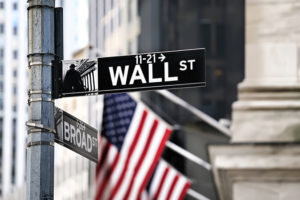A low in the yield curve? What could it mean for the US S&P500 or NASDAQ indices?
Short term for over a year US government bonds yield higher returns than their counterparts with long maturities. Last week the difference between these two particular bonds was the biggest since 1981 and amounted to 1,08 pp.
An inversion of the yield curve is a classic signal that recession is on the horizon. In the past, it took an average of 15 months for the economy to go into recession after the yield curve inverted.
Reversal of the inverted curve?
Under normal circumstances, the yield curve is steep, which means that long-term bonds have a higher yield than short-term bonds. This is a compensation for the risk associated with a longer investment period.
However, sometimes the yield curve can invert. This means that the yield on short-term bonds is higher than on long-term bonds. This phenomenon is rare and is often considered a signal of an upcoming recession. This is because investors anticipate that interest rates will fall in the future, which usually happens during recessions.
An inversion of the yield curve is bad news for the economy for two additional reasons. First, it slows down the lending business of banks as banks make money from short-term lending and long-term lending. The inversion of the yield curve makes the math unprofitable for banks in many cases. This means they are more reluctant to lend to companies that are struggling to grow, slowing down the economy.
Second, the inversion of the yield curve heralding a recession is a kind of self-fulfilling prophecy. By moving money from short-term bonds to long-term bonds, investors are expressing the belief that the economic slowdown will come sooner rather than later.
CHECK: How to invest in bonds? Beginner's Guide [Tutorial]
The yield curve and the approach of investors and companies
An inversion of the yield curve can also lead to a change in investors' risk appetite. If investors anticipate a recession, they may choose to sell stocks that are considered riskier and move their investments to safer assets such as government bonds. This can also lead to a drop in stock prices.
Additionally, if companies anticipate a recession, they may choose to reduce investment and spending, which can lead to slower growth and lower profits. This can also negatively affect stock prices.
However, it is worth remembering that a yield curve inversion is just one of many factors that can affect the stock market. Even after the reversal of the inverted curve began, the stock market in the past seemed to do quite well for many months after the event.
For now, however, the market would have to confirm that the bottom of the yield curve has already been set in July 2023.






















![Forex Club – Tax 9 – Settle tax on a foreign broker [Download the Application] Forex Club - Tax 9](https://forexclub.pl/wp-content/uploads/2024/02/Forex-Club-Podatek-9-184x120.jpg?v=1709046278)
![Trading View platform – solutions tailored to the needs of traders [Review] trading view review](https://forexclub.pl/wp-content/uploads/2024/03/trading-view-recenzja-184x120.jpg?v=1709558918)
![How to connect your FP Markets account to the Trading View platform [Guide] fp markets trading view](https://forexclub.pl/wp-content/uploads/2024/02/fp-markets-trading-view-184x120.jpg?v=1708677291)
![CRB index – one of the popular commodity market benchmarks [Guide] crb index](https://forexclub.pl/wp-content/uploads/2024/05/indeks-crb-184x120.jpg?v=1715055656)
![How to invest in ChatGPT and AI? Stocks and ETFs [Guide] how to invest in chatgpt and artificial intelligence](https://forexclub.pl/wp-content/uploads/2023/02/jak-inwestowac-w-chatgpt-i-sztuczna-inteligencje-184x120.jpg?v=1676364263)






![Izabela Górecka – “Success on the market depends not only on knowledge, but also on emotional stability” [Interview] Izabela Górecka - interview](https://forexclub.pl/wp-content/uploads/2024/04/Izabela-Gorecka-wywiad-184x120.jpg?v=1713870578)
![WeWork – the anatomy of the collapse of a company valued at $47 billion [WeWork, part II] wework bankruptcy story](https://forexclub.pl/wp-content/uploads/2024/04/wework-bankructwo-historia-184x120.jpg?v=1711729561)
![Adam Neumann – the man who screwed up Softbank [WeWork, part AND] adam neumann wework](https://forexclub.pl/wp-content/uploads/2024/04/adam-neumann-wework-184x120.jpg?v=1711728724)

![The most common mistakes of a beginner trader - Mr Yogi [VIDEO] Scalping - The most common mistakes of a beginner trader - VIDEO](https://forexclub.pl/wp-content/uploads/2024/03/Scalping-Najczestsze-bledy-poczatkujacego-tradera-VIDEO-184x120.jpg?v=1711601376)
![Learning patience: No position is also a position - Mr Yogi [VIDEO] Scalping - Learning patience - No position is also a position - VIDEO](https://forexclub.pl/wp-content/uploads/2024/03/Scalping-Nauka-cierpliwosci-Brak-pozycji-to-tez-pozycja-VIDEO-184x120.jpg?v=1710999249)
![When to exit a position and how to minimize losses - Mr Yogi [VIDEO] Scalping - When to exit a position and how to minimize losses - VIDEO](https://forexclub.pl/wp-content/uploads/2024/03/Scalping-Kiedy-wyjsc-z-pozycji-i-jak-minimalizowac-straty-VIDEO-184x120.jpg?v=1710336731)






![How to transfer shares to another brokerage office [Procedure description] how to transfer shares to another brokerage house](https://forexclub.pl/wp-content/uploads/2024/03/jak-przeniesc-akcje-do-innego-biura-maklerskiego-300x200.jpg?v=1709556924)











